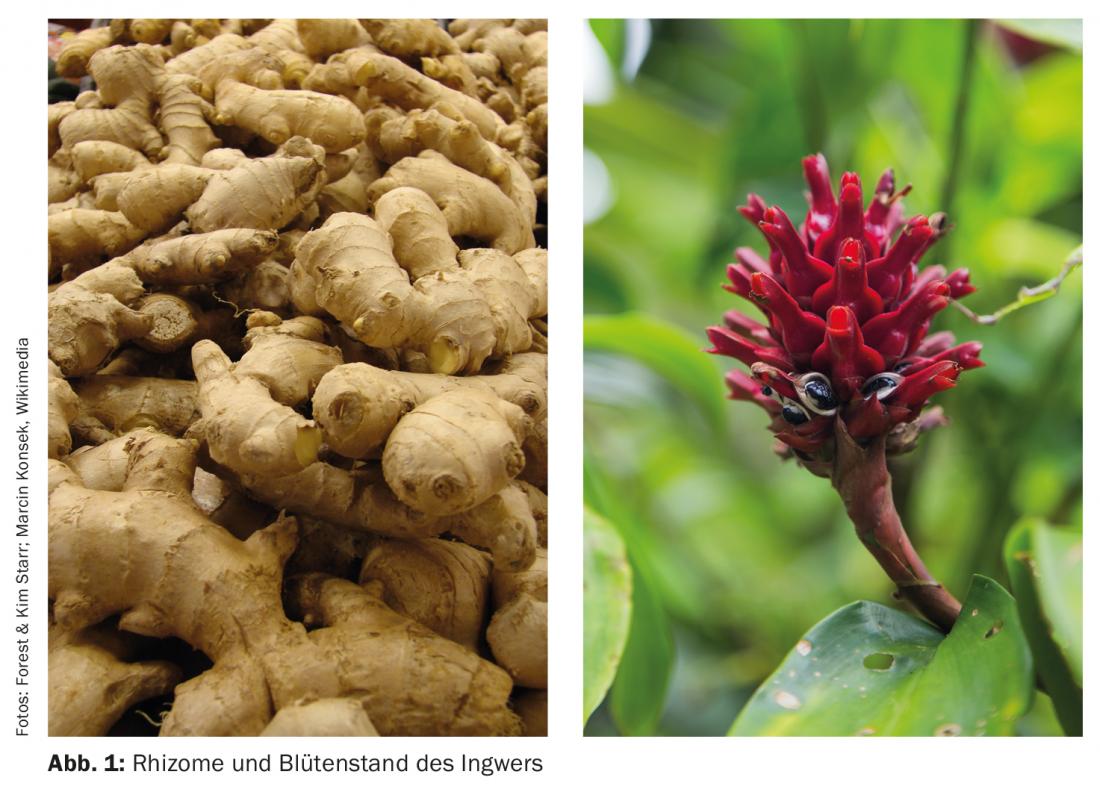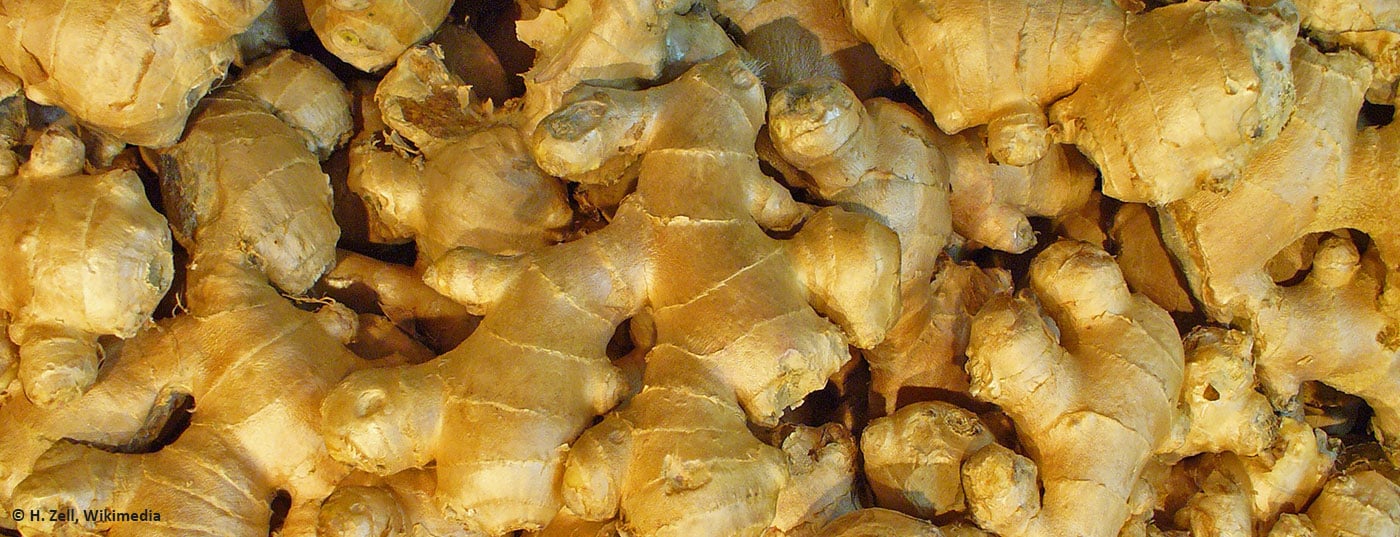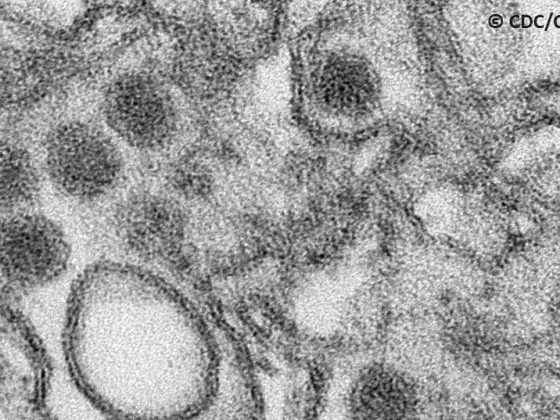Ginger on travel: For reactions of the organism to movement influences, ginger is a proven helper. Symptoms of motion sickness such as nausea and vomiting have been shown to be relieved by ginger.
Kinetosis, motion sickness, is actually not a disease in the medical sense, but a reaction of our organism to motion influences, which occur mainly on ships, but also in cars and other means of motion such as e.g. Roller coasters occur. The causes of kinetosis are still debated in the scientific community. One possible explanation for the occurrence of nausea and vomiting is inconsistent sensory input to the visual and vestibular systems.
Ginger
Ginger (English: Ginger, Latin: Zingiber officinale), is a plant of the ginger family (Latin: Zingiberaceae). Their original home are tropical and subtropical areas. Ginger grows for several years and can reach a height of 100 cm. It has a characteristic red inflorescence that grows directly from underground stem parts called rhizomes (Fig. 1) . These rhizomes are used as a spice and for medicinal purposes.

The rhizome of Zingiber officinale contains 1-3% essential oils, the main component of which is a sesquiterpene, (-)-zingiberene. This can account for up to 70% of the essential oil. In addition, (+)-ar-curcume, beta-sesquiphellandrene, bisabolene and farnesene are found. Further it contains traces of monoterpenes. Ginger gets its pungent flavor from a non-volatile resin containing zingerone, gingerols and shoagols – substances characteristic of the ginger family.
Ginger is a kitchen spice that originated in Asian cuisine, but is now used worldwide. In the Orient, coffee and tea are also often flavored with ginger. Ginger gives beverages, which are also often used in the Western world, their characteristic taste. These include, for example. Ginger ale and ginger beer.
Medical efficacy
In studies investigating the efficacy of ginger in kinetosis, three studies have shown a positive result from ginger [1–3], while three other studies have failed to demonstrate any symptom-relieving effect of ginger [4–6]. The total number of subjects in these six studies was 323. Two studies [1,3] were conducted on the high seas, while the other 4 studies took place in the laboratory, with subjects in the latter case having kinetosis induced with a swivel chair. In addition to ginger, several established antiemetics were used as comparator medications.
Groentved et al. conducted a study under real conditions in 1988. They studied the effect of ginger on seasickness with 80 Danish sea cadets [1]. None of these cadets had any previous ocean experience. The 80 subjects received either 1 g of ginger powder or the same amount of placebo. Seasickness symptoms were collected from the subjects every hour for four hours. The tendency to vomit and the appearance of cold sweat were determined. Ginger reduced the likelihood of vomiting and cold sweats more than the placebo (p<0.05).
In the study by Schmid et al. [3], the efficacy of seven different seasickness agents was studied, namely cinnarizine, cinnarizine with domperidone, cyclizine, dimenhydrinate with caffeine, ginger root, meclozine with caffeine, and scopolamine. The study was conducted as a randomized, double-blind, two-arm trial. For ethical reasons, there was no placebo group in this study because in a previous study with a placebo group, 80% of the subjects in this group became seasick. The subjects in the study by Schmid et al. were 1741 volunteers who participated in a whale safari as tourists in Norway. The main endpoints were vomiting, malaise, and subjective reports of adverse events. 1489 subjects (85.5%) participated in follow-up.
4.1-10.2% of subjects in the seven groups suffered from vomiting and 16.4-23.5% from nausea while at sea. This corresponded to a non-significant number of participants. Further, no significant difference in the number and type of adverse events was observed between the groups. The group treated with a transdermal scopolamine system experienced slightly more eye and vision problems than the other groups, and scopolamine appeared to be the agent with the least effect.
In the studies conducted in the laboratory by Stewart et al. In 1991, kinetosis was induced in subjects using a swivel chair. Stewart et al. [4] compared ginger with scopolamine and placebo. This was done to determine how many head movements the subjects could make until just before vomiting (n=28). Ginger did not provide any protection against symptoms of motion sickness. Also, the patients were not able to perform more head movements than when they had received placebo. In contrast, subjects were able to perform significantly more head movements after taking scopolamine than after taking placebo (p<0.01). Ginger was also not shown to be superior to placebo in terms of electrogastrogram.
The studies by Stott [5] and Wood [6] concluded no significant beneficial effect of ginger.
Discussion
Thus, there are three negative and three positive efficacy studies. It is striking that both studies, which were conducted on the high seas, i.e. under realistic conditions, came to a positive result. Three of the four laboratory studies failed to determine efficacy for ginger. However, kinetosis induced in the laboratory is only an approximation of natural kinetosis because it is triggered rapidly and violently. This could be one reason why no efficacy has been shown for ginger in laboratory studies. The “only” three positive studies on the efficacy of ginger for the treatment or prophylaxis of kinetosis contrast with many studies documenting the efficacy of ginger for pregnancy-related and postoperative nausea and vomiting. However, these are not the subject of this article.
Summary
Considering the positive studies conducted on the high seas and the reflections on the laboratory studies, the question about the effectiveness of ginger against kinetosis can be answered positively. Ginger preparations are therefore suitable as an alternative to synthetic preparations for the therapy and prophylaxis of kinetosis.
Literature:
- Groentved A, et al.: Ginger root against seasick-ness. A controlled trial on the open sea. Acta Otolaryngol. 1988 Jan-Feb; 105(1-2): 45-49.
- Mowrey DB, Clayson DE: Motion sickness, ginger, and psychophysics. Lancet. 1982 Mar 20; 1(8273): 655-657.
- Schmid R, et al: Comparison of seven com-monly used agents for prophylaxis of seasickness. J Travel Med. 1994 Dec 1; 1(4): 203-206.
- Stewart JJ, et al: Effects of ginger on motion sickness susceptibility and gastric function. Pharmacology. 1991; 42(2): 111-120.
- Stott JR, Hubble MP, Spencer MB: A double-blind comparative trial of powdered ginger root, hyosine hydrobromide, and cinnarizine in the prophylaxis of motion sickness induced by cross coupled stimulation. AGARD Conf Proc. 1985; (372): 1-6.
- Wood CD, et al: Comparison of efficacy of ginger with various antimotion sickness drugs. Clin Res Pr Drug Regul Aff. 1988; 6(2): 129-136.
HAUSARZT PRAXIS 2017; 12(6): 3-4











